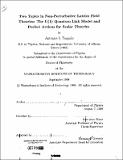Two topics in non-perturbative lattice field theories : the U(1) quantum link model and perfect actions for scalar theories
Author(s)
Tsapalis, Antonios S., 1968-
DownloadFull printable version (11.67Mb)
Alternative title
2 topics in non-perturbative lattice field theories
U(1) quantum link model
Perfect actions for scalar theories
Advisor
Uwe-Jens Wiese.
Terms of use
Metadata
Show full item recordAbstract
This thesis deals with two topics in lattice field theories. In the first part we discuss aspects of renormalization group flow and non-perturbative improvement of actions for scalar theories regularized on a lattice. We construct a perfect action, an action which is free of lattice artifacts, for a given theory. It is shown how a good approximation to the perfect action - referred to as classically perfect - can be constructed based on a well-defined blocking scheme for the 0(3) non-linear o-model. We study the O(N) non-linear r-model in the large-N limit and derive analytically its perfect action. This action is applied to the 0(3) model on a square lattice. The Wolff cluster algorithm is used to simulate numerically the system. We perform scaling tests and discuss the scaling properties of the large-N inspired perfect action as opposed to the standard and the classically perfect action. In the second part we present a new formulation for a quantum field theory with Abelian gauge symmetry. A Hamiltonian is constructed on a four-dimensional Euclidean space-time lattice which is invariant under local transformations. The model is formulated as a 5-dimensional path integral of discrete variables. We argue that dimensional reduction will allow us to study the behavior of the standard compact U(1) gauge theory in 4-d. Based on the idea of the loop-cluster algorithm for quantum spins, we present the construction of a flux-cluster algorithm for the U(1) quantum link model for the spin-1/2 quantization of the electric flux. It is shown how improved estimators for Wilson loop expectation values can be defined. This is important because the Wilson loops are traditionally used to identify confining and Coulomb phases in gauge theories. Our study indicates that the spin-1/2 U(1) quantum link model is strongly coupled for all bare coupling values we examined.
Description
Thesis (Ph.D.)--Massachusetts Institute of Technology, Dept. of Physics, 1998. Includes bibliographical references (leaves 175-179).
Date issued
1998Department
Massachusetts Institute of Technology. Department of PhysicsPublisher
Massachusetts Institute of Technology
Keywords
Physics